401211 Health Variations 4: Acute Life Threatening Conditions
VerifiedAdded on 2023/01/18
|8
|2175
|97
Homework Assignment
AI Summary
This assignment analyzes a case study of a 75-year-old male, Mr. Kirkman, who presented with a urinary tract infection (UTI) that progressed to severe sepsis. The analysis delves into the clinical presentation, risk factors, and the patient's deteriorating condition, including symptoms like high temperature, rapid breathing, and low blood pressure. It examines the rationale for prioritizing oxygen therapy to prevent further complications and discusses the importance of arterial blood gas (ABG) analysis in monitoring the patient's acid-base balance, gas exchange, and respiratory status. The assignment highlights the interpretation of ABG results, including pH, PaCO2, base excess, and lactate levels, in relation to the patient's condition and the underlying pathogenesis. The document also includes references to relevant studies and guidelines.
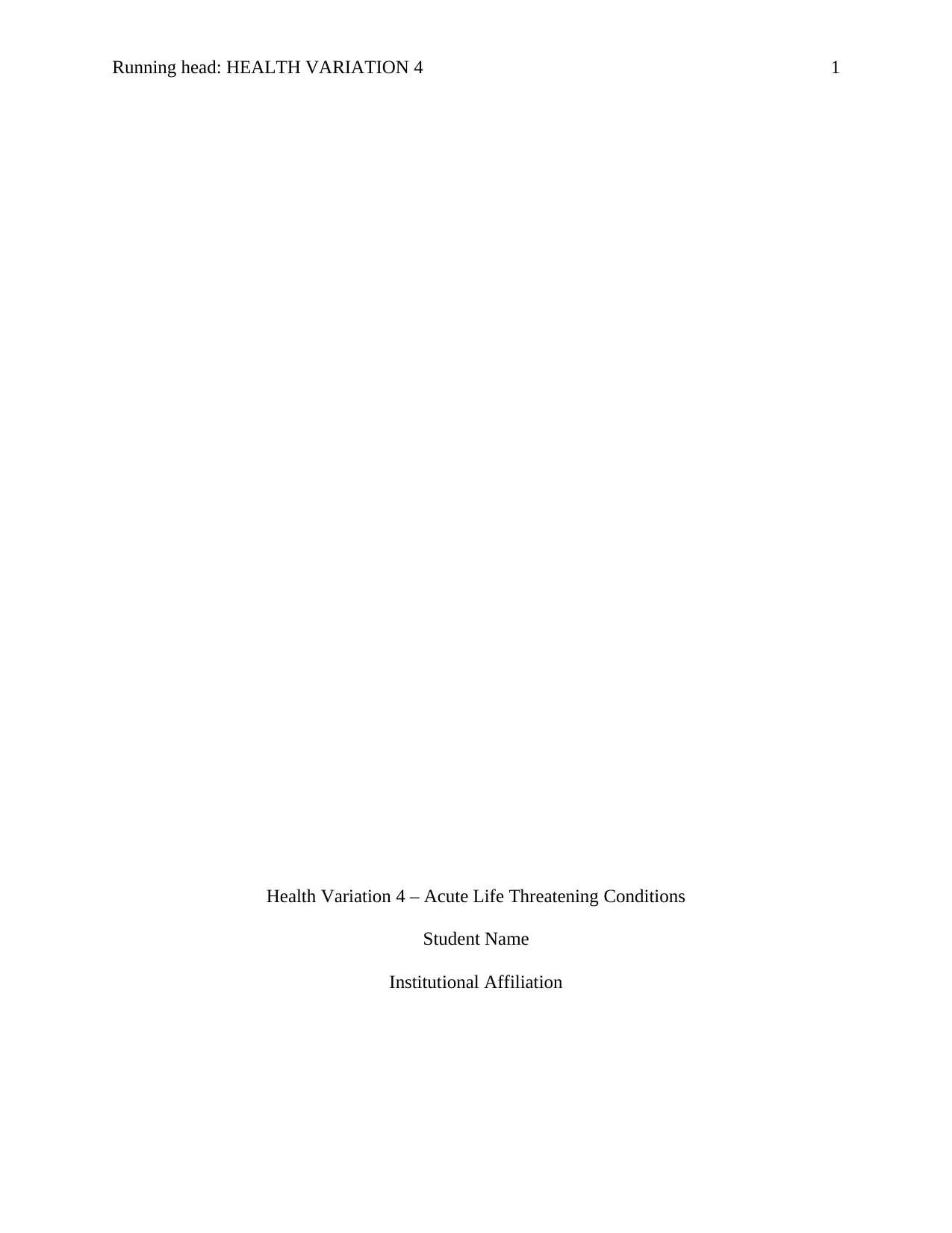
Running head: HEALTH VARIATION 4 1
Health Variation 4 – Acute Life Threatening Conditions
Student Name
Institutional Affiliation
Health Variation 4 – Acute Life Threatening Conditions
Student Name
Institutional Affiliation
Paraphrase This Document
Need a fresh take? Get an instant paraphrase of this document with our AI Paraphraser
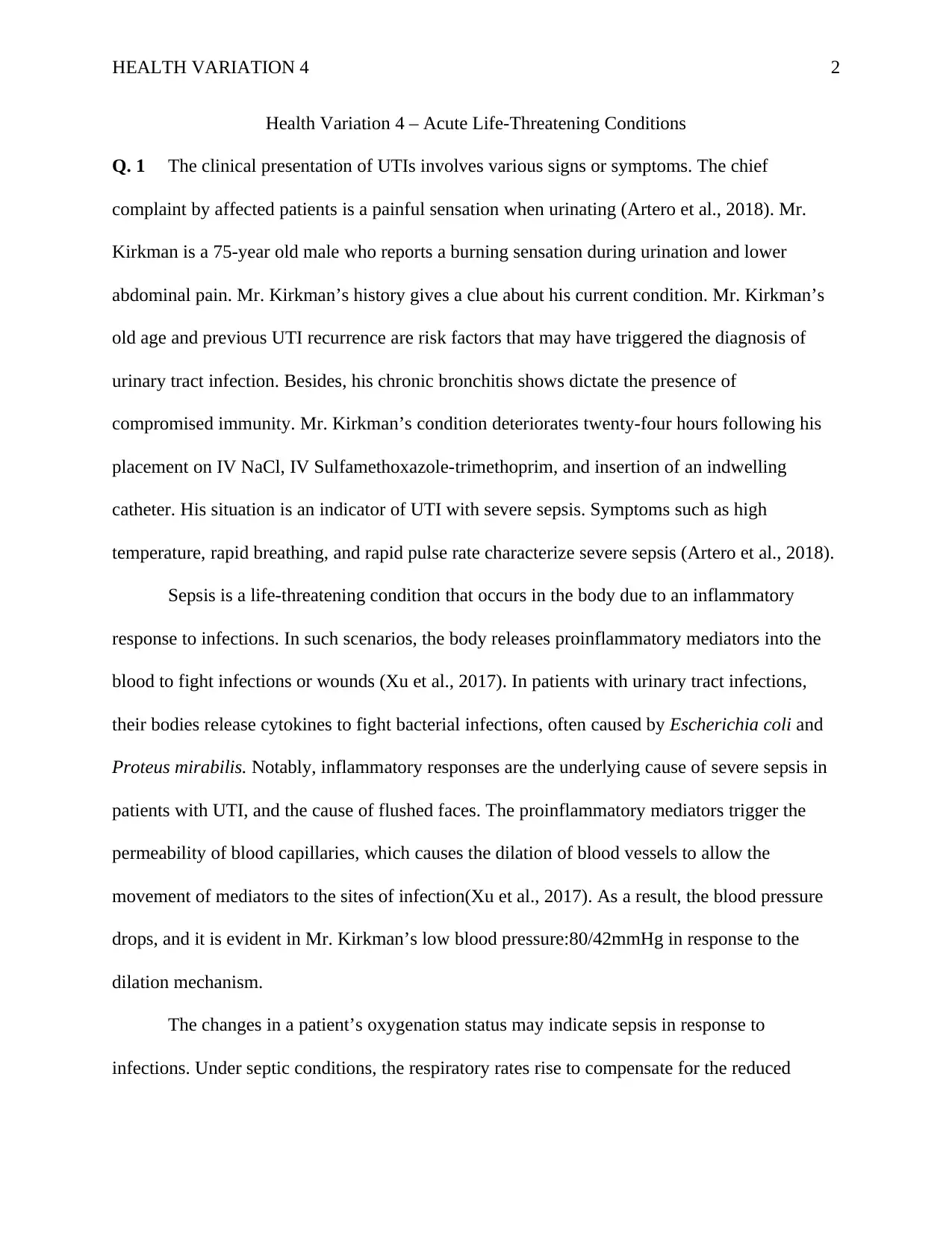
HEALTH VARIATION 4 2
Health Variation 4 – Acute Life-Threatening Conditions
Q. 1 The clinical presentation of UTIs involves various signs or symptoms. The chief
complaint by affected patients is a painful sensation when urinating (Artero et al., 2018). Mr.
Kirkman is a 75-year old male who reports a burning sensation during urination and lower
abdominal pain. Mr. Kirkman’s history gives a clue about his current condition. Mr. Kirkman’s
old age and previous UTI recurrence are risk factors that may have triggered the diagnosis of
urinary tract infection. Besides, his chronic bronchitis shows dictate the presence of
compromised immunity. Mr. Kirkman’s condition deteriorates twenty-four hours following his
placement on IV NaCl, IV Sulfamethoxazole-trimethoprim, and insertion of an indwelling
catheter. His situation is an indicator of UTI with severe sepsis. Symptoms such as high
temperature, rapid breathing, and rapid pulse rate characterize severe sepsis (Artero et al., 2018).
Sepsis is a life-threatening condition that occurs in the body due to an inflammatory
response to infections. In such scenarios, the body releases proinflammatory mediators into the
blood to fight infections or wounds (Xu et al., 2017). In patients with urinary tract infections,
their bodies release cytokines to fight bacterial infections, often caused by Escherichia coli and
Proteus mirabilis. Notably, inflammatory responses are the underlying cause of severe sepsis in
patients with UTI, and the cause of flushed faces. The proinflammatory mediators trigger the
permeability of blood capillaries, which causes the dilation of blood vessels to allow the
movement of mediators to the sites of infection(Xu et al., 2017). As a result, the blood pressure
drops, and it is evident in Mr. Kirkman’s low blood pressure:80/42mmHg in response to the
dilation mechanism.
The changes in a patient’s oxygenation status may indicate sepsis in response to
infections. Under septic conditions, the respiratory rates rise to compensate for the reduced
Health Variation 4 – Acute Life-Threatening Conditions
Q. 1 The clinical presentation of UTIs involves various signs or symptoms. The chief
complaint by affected patients is a painful sensation when urinating (Artero et al., 2018). Mr.
Kirkman is a 75-year old male who reports a burning sensation during urination and lower
abdominal pain. Mr. Kirkman’s history gives a clue about his current condition. Mr. Kirkman’s
old age and previous UTI recurrence are risk factors that may have triggered the diagnosis of
urinary tract infection. Besides, his chronic bronchitis shows dictate the presence of
compromised immunity. Mr. Kirkman’s condition deteriorates twenty-four hours following his
placement on IV NaCl, IV Sulfamethoxazole-trimethoprim, and insertion of an indwelling
catheter. His situation is an indicator of UTI with severe sepsis. Symptoms such as high
temperature, rapid breathing, and rapid pulse rate characterize severe sepsis (Artero et al., 2018).
Sepsis is a life-threatening condition that occurs in the body due to an inflammatory
response to infections. In such scenarios, the body releases proinflammatory mediators into the
blood to fight infections or wounds (Xu et al., 2017). In patients with urinary tract infections,
their bodies release cytokines to fight bacterial infections, often caused by Escherichia coli and
Proteus mirabilis. Notably, inflammatory responses are the underlying cause of severe sepsis in
patients with UTI, and the cause of flushed faces. The proinflammatory mediators trigger the
permeability of blood capillaries, which causes the dilation of blood vessels to allow the
movement of mediators to the sites of infection(Xu et al., 2017). As a result, the blood pressure
drops, and it is evident in Mr. Kirkman’s low blood pressure:80/42mmHg in response to the
dilation mechanism.
The changes in a patient’s oxygenation status may indicate sepsis in response to
infections. Under septic conditions, the respiratory rates rise to compensate for the reduced
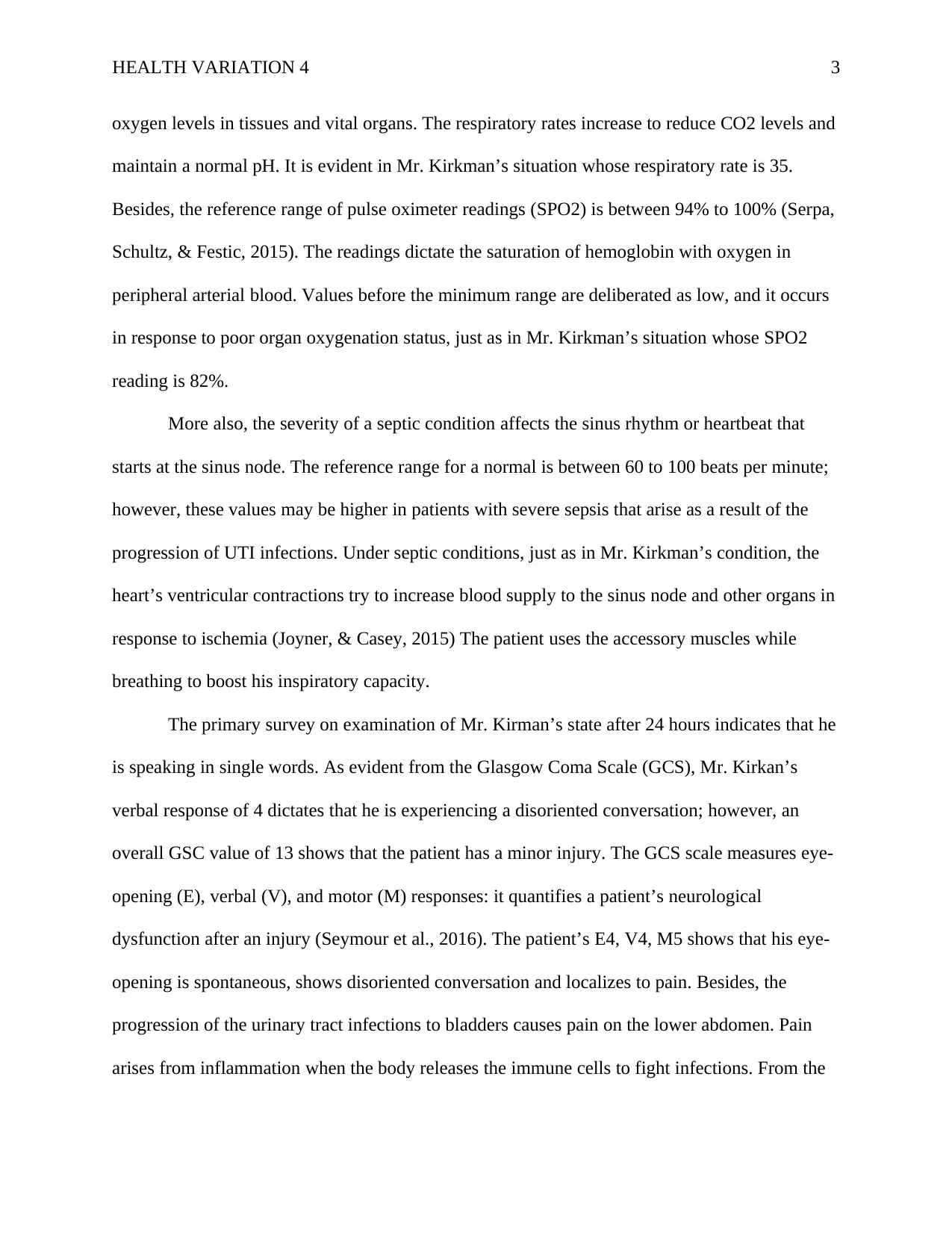
HEALTH VARIATION 4 3
oxygen levels in tissues and vital organs. The respiratory rates increase to reduce CO2 levels and
maintain a normal pH. It is evident in Mr. Kirkman’s situation whose respiratory rate is 35.
Besides, the reference range of pulse oximeter readings (SPO2) is between 94% to 100% (Serpa,
Schultz, & Festic, 2015). The readings dictate the saturation of hemoglobin with oxygen in
peripheral arterial blood. Values before the minimum range are deliberated as low, and it occurs
in response to poor organ oxygenation status, just as in Mr. Kirkman’s situation whose SPO2
reading is 82%.
More also, the severity of a septic condition affects the sinus rhythm or heartbeat that
starts at the sinus node. The reference range for a normal is between 60 to 100 beats per minute;
however, these values may be higher in patients with severe sepsis that arise as a result of the
progression of UTI infections. Under septic conditions, just as in Mr. Kirkman’s condition, the
heart’s ventricular contractions try to increase blood supply to the sinus node and other organs in
response to ischemia (Joyner, & Casey, 2015) The patient uses the accessory muscles while
breathing to boost his inspiratory capacity.
The primary survey on examination of Mr. Kirman’s state after 24 hours indicates that he
is speaking in single words. As evident from the Glasgow Coma Scale (GCS), Mr. Kirkan’s
verbal response of 4 dictates that he is experiencing a disoriented conversation; however, an
overall GSC value of 13 shows that the patient has a minor injury. The GCS scale measures eye-
opening (E), verbal (V), and motor (M) responses: it quantifies a patient’s neurological
dysfunction after an injury (Seymour et al., 2016). The patient’s E4, V4, M5 shows that his eye-
opening is spontaneous, shows disoriented conversation and localizes to pain. Besides, the
progression of the urinary tract infections to bladders causes pain on the lower abdomen. Pain
arises from inflammation when the body releases the immune cells to fight infections. From the
oxygen levels in tissues and vital organs. The respiratory rates increase to reduce CO2 levels and
maintain a normal pH. It is evident in Mr. Kirkman’s situation whose respiratory rate is 35.
Besides, the reference range of pulse oximeter readings (SPO2) is between 94% to 100% (Serpa,
Schultz, & Festic, 2015). The readings dictate the saturation of hemoglobin with oxygen in
peripheral arterial blood. Values before the minimum range are deliberated as low, and it occurs
in response to poor organ oxygenation status, just as in Mr. Kirkman’s situation whose SPO2
reading is 82%.
More also, the severity of a septic condition affects the sinus rhythm or heartbeat that
starts at the sinus node. The reference range for a normal is between 60 to 100 beats per minute;
however, these values may be higher in patients with severe sepsis that arise as a result of the
progression of UTI infections. Under septic conditions, just as in Mr. Kirkman’s condition, the
heart’s ventricular contractions try to increase blood supply to the sinus node and other organs in
response to ischemia (Joyner, & Casey, 2015) The patient uses the accessory muscles while
breathing to boost his inspiratory capacity.
The primary survey on examination of Mr. Kirman’s state after 24 hours indicates that he
is speaking in single words. As evident from the Glasgow Coma Scale (GCS), Mr. Kirkan’s
verbal response of 4 dictates that he is experiencing a disoriented conversation; however, an
overall GSC value of 13 shows that the patient has a minor injury. The GCS scale measures eye-
opening (E), verbal (V), and motor (M) responses: it quantifies a patient’s neurological
dysfunction after an injury (Seymour et al., 2016). The patient’s E4, V4, M5 shows that his eye-
opening is spontaneous, shows disoriented conversation and localizes to pain. Besides, the
progression of the urinary tract infections to bladders causes pain on the lower abdomen. Pain
arises from inflammation when the body releases the immune cells to fight infections. From the
⊘ This is a preview!⊘
Do you want full access?
Subscribe today to unlock all pages.

Trusted by 1+ million students worldwide
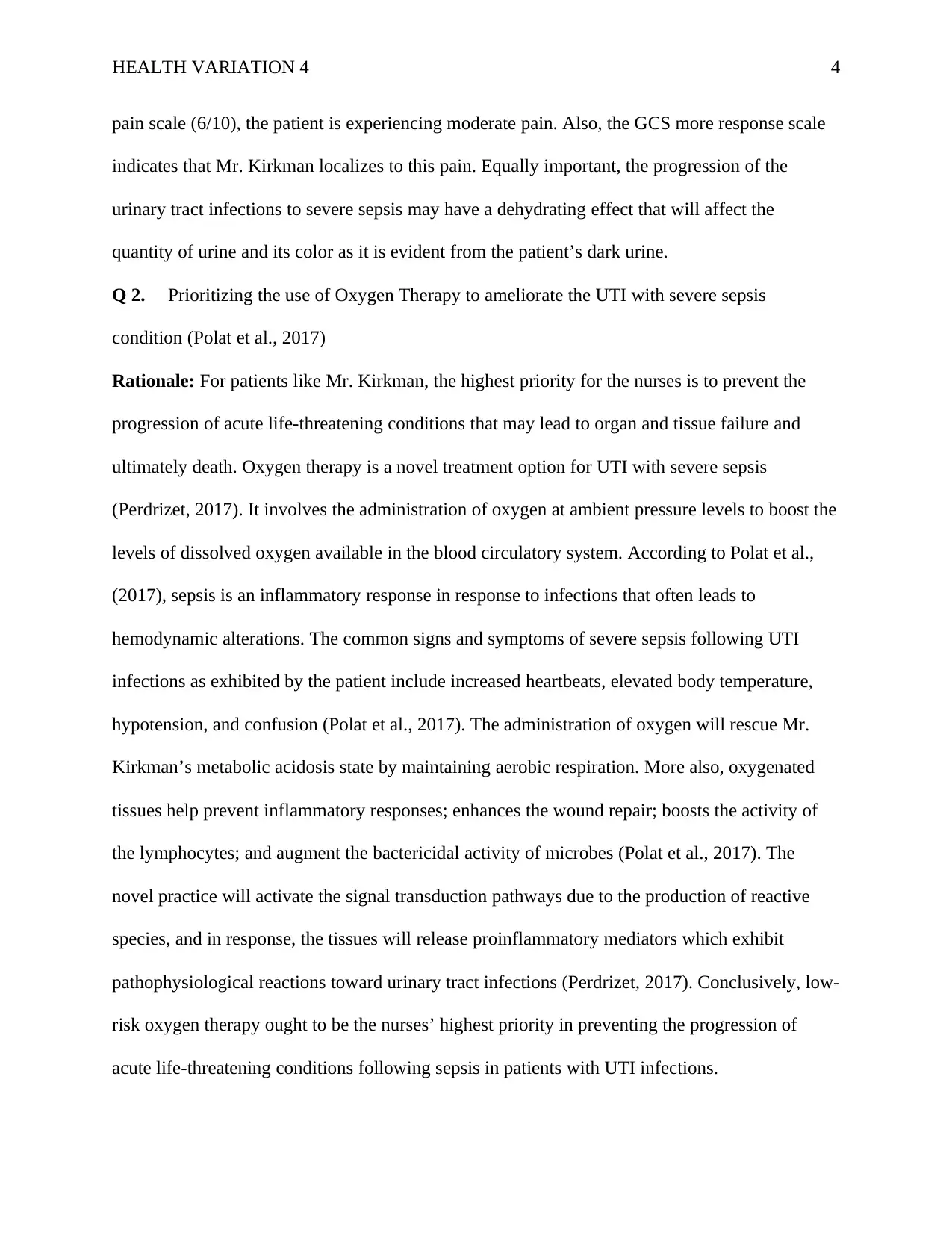
HEALTH VARIATION 4 4
pain scale (6/10), the patient is experiencing moderate pain. Also, the GCS more response scale
indicates that Mr. Kirkman localizes to this pain. Equally important, the progression of the
urinary tract infections to severe sepsis may have a dehydrating effect that will affect the
quantity of urine and its color as it is evident from the patient’s dark urine.
Q 2. Prioritizing the use of Oxygen Therapy to ameliorate the UTI with severe sepsis
condition (Polat et al., 2017)
Rationale: For patients like Mr. Kirkman, the highest priority for the nurses is to prevent the
progression of acute life-threatening conditions that may lead to organ and tissue failure and
ultimately death. Oxygen therapy is a novel treatment option for UTI with severe sepsis
(Perdrizet, 2017). It involves the administration of oxygen at ambient pressure levels to boost the
levels of dissolved oxygen available in the blood circulatory system. According to Polat et al.,
(2017), sepsis is an inflammatory response in response to infections that often leads to
hemodynamic alterations. The common signs and symptoms of severe sepsis following UTI
infections as exhibited by the patient include increased heartbeats, elevated body temperature,
hypotension, and confusion (Polat et al., 2017). The administration of oxygen will rescue Mr.
Kirkman’s metabolic acidosis state by maintaining aerobic respiration. More also, oxygenated
tissues help prevent inflammatory responses; enhances the wound repair; boosts the activity of
the lymphocytes; and augment the bactericidal activity of microbes (Polat et al., 2017). The
novel practice will activate the signal transduction pathways due to the production of reactive
species, and in response, the tissues will release proinflammatory mediators which exhibit
pathophysiological reactions toward urinary tract infections (Perdrizet, 2017). Conclusively, low-
risk oxygen therapy ought to be the nurses’ highest priority in preventing the progression of
acute life-threatening conditions following sepsis in patients with UTI infections.
pain scale (6/10), the patient is experiencing moderate pain. Also, the GCS more response scale
indicates that Mr. Kirkman localizes to this pain. Equally important, the progression of the
urinary tract infections to severe sepsis may have a dehydrating effect that will affect the
quantity of urine and its color as it is evident from the patient’s dark urine.
Q 2. Prioritizing the use of Oxygen Therapy to ameliorate the UTI with severe sepsis
condition (Polat et al., 2017)
Rationale: For patients like Mr. Kirkman, the highest priority for the nurses is to prevent the
progression of acute life-threatening conditions that may lead to organ and tissue failure and
ultimately death. Oxygen therapy is a novel treatment option for UTI with severe sepsis
(Perdrizet, 2017). It involves the administration of oxygen at ambient pressure levels to boost the
levels of dissolved oxygen available in the blood circulatory system. According to Polat et al.,
(2017), sepsis is an inflammatory response in response to infections that often leads to
hemodynamic alterations. The common signs and symptoms of severe sepsis following UTI
infections as exhibited by the patient include increased heartbeats, elevated body temperature,
hypotension, and confusion (Polat et al., 2017). The administration of oxygen will rescue Mr.
Kirkman’s metabolic acidosis state by maintaining aerobic respiration. More also, oxygenated
tissues help prevent inflammatory responses; enhances the wound repair; boosts the activity of
the lymphocytes; and augment the bactericidal activity of microbes (Polat et al., 2017). The
novel practice will activate the signal transduction pathways due to the production of reactive
species, and in response, the tissues will release proinflammatory mediators which exhibit
pathophysiological reactions toward urinary tract infections (Perdrizet, 2017). Conclusively, low-
risk oxygen therapy ought to be the nurses’ highest priority in preventing the progression of
acute life-threatening conditions following sepsis in patients with UTI infections.
Paraphrase This Document
Need a fresh take? Get an instant paraphrase of this document with our AI Paraphraser
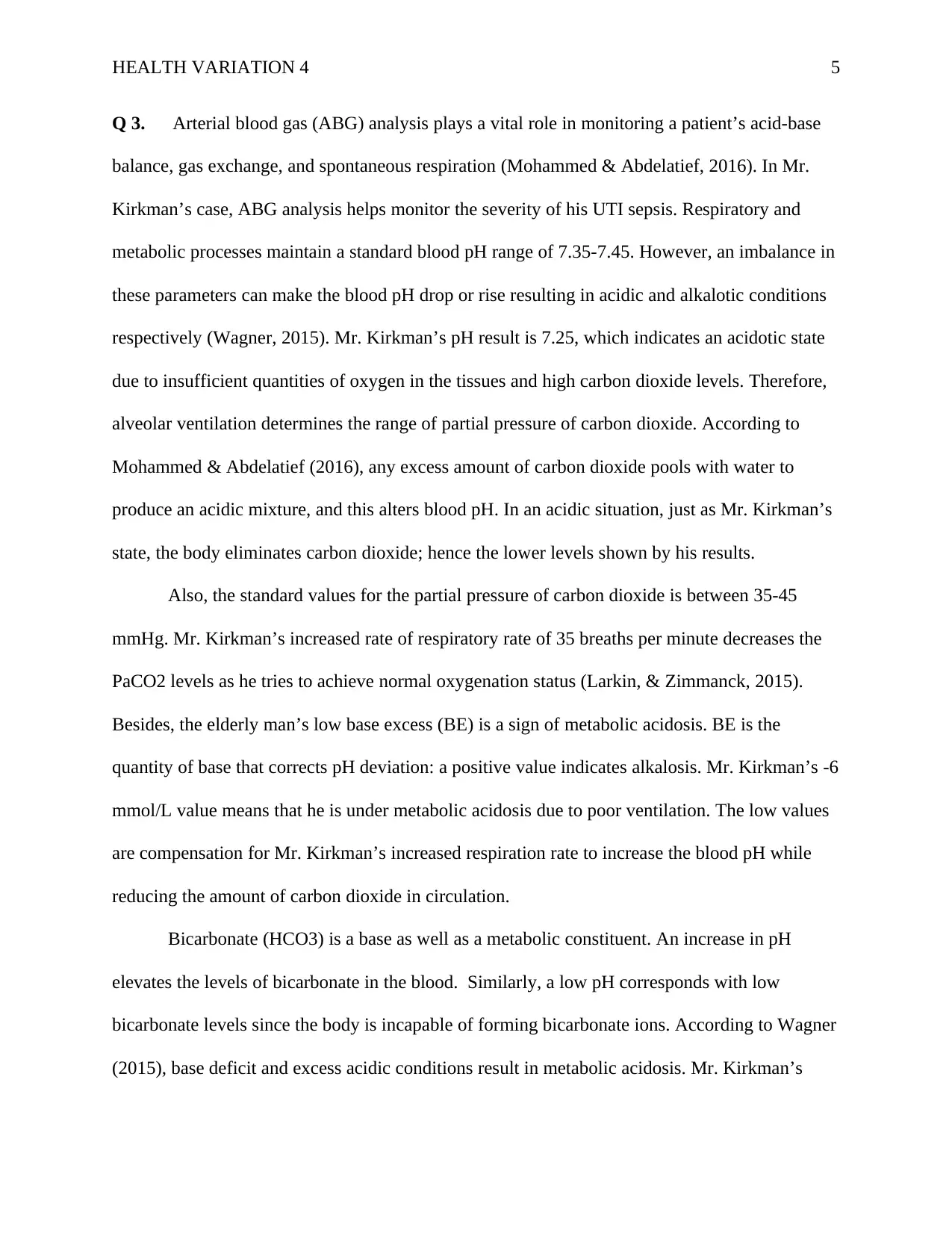
HEALTH VARIATION 4 5
Q 3. Arterial blood gas (ABG) analysis plays a vital role in monitoring a patient’s acid-base
balance, gas exchange, and spontaneous respiration (Mohammed & Abdelatief, 2016). In Mr.
Kirkman’s case, ABG analysis helps monitor the severity of his UTI sepsis. Respiratory and
metabolic processes maintain a standard blood pH range of 7.35-7.45. However, an imbalance in
these parameters can make the blood pH drop or rise resulting in acidic and alkalotic conditions
respectively (Wagner, 2015). Mr. Kirkman’s pH result is 7.25, which indicates an acidotic state
due to insufficient quantities of oxygen in the tissues and high carbon dioxide levels. Therefore,
alveolar ventilation determines the range of partial pressure of carbon dioxide. According to
Mohammed & Abdelatief (2016), any excess amount of carbon dioxide pools with water to
produce an acidic mixture, and this alters blood pH. In an acidic situation, just as Mr. Kirkman’s
state, the body eliminates carbon dioxide; hence the lower levels shown by his results.
Also, the standard values for the partial pressure of carbon dioxide is between 35-45
mmHg. Mr. Kirkman’s increased rate of respiratory rate of 35 breaths per minute decreases the
PaCO2 levels as he tries to achieve normal oxygenation status (Larkin, & Zimmanck, 2015).
Besides, the elderly man’s low base excess (BE) is a sign of metabolic acidosis. BE is the
quantity of base that corrects pH deviation: a positive value indicates alkalosis. Mr. Kirkman’s -6
mmol/L value means that he is under metabolic acidosis due to poor ventilation. The low values
are compensation for Mr. Kirkman’s increased respiration rate to increase the blood pH while
reducing the amount of carbon dioxide in circulation.
Bicarbonate (HCO3) is a base as well as a metabolic constituent. An increase in pH
elevates the levels of bicarbonate in the blood. Similarly, a low pH corresponds with low
bicarbonate levels since the body is incapable of forming bicarbonate ions. According to Wagner
(2015), base deficit and excess acidic conditions result in metabolic acidosis. Mr. Kirkman’s
Q 3. Arterial blood gas (ABG) analysis plays a vital role in monitoring a patient’s acid-base
balance, gas exchange, and spontaneous respiration (Mohammed & Abdelatief, 2016). In Mr.
Kirkman’s case, ABG analysis helps monitor the severity of his UTI sepsis. Respiratory and
metabolic processes maintain a standard blood pH range of 7.35-7.45. However, an imbalance in
these parameters can make the blood pH drop or rise resulting in acidic and alkalotic conditions
respectively (Wagner, 2015). Mr. Kirkman’s pH result is 7.25, which indicates an acidotic state
due to insufficient quantities of oxygen in the tissues and high carbon dioxide levels. Therefore,
alveolar ventilation determines the range of partial pressure of carbon dioxide. According to
Mohammed & Abdelatief (2016), any excess amount of carbon dioxide pools with water to
produce an acidic mixture, and this alters blood pH. In an acidic situation, just as Mr. Kirkman’s
state, the body eliminates carbon dioxide; hence the lower levels shown by his results.
Also, the standard values for the partial pressure of carbon dioxide is between 35-45
mmHg. Mr. Kirkman’s increased rate of respiratory rate of 35 breaths per minute decreases the
PaCO2 levels as he tries to achieve normal oxygenation status (Larkin, & Zimmanck, 2015).
Besides, the elderly man’s low base excess (BE) is a sign of metabolic acidosis. BE is the
quantity of base that corrects pH deviation: a positive value indicates alkalosis. Mr. Kirkman’s -6
mmol/L value means that he is under metabolic acidosis due to poor ventilation. The low values
are compensation for Mr. Kirkman’s increased respiration rate to increase the blood pH while
reducing the amount of carbon dioxide in circulation.
Bicarbonate (HCO3) is a base as well as a metabolic constituent. An increase in pH
elevates the levels of bicarbonate in the blood. Similarly, a low pH corresponds with low
bicarbonate levels since the body is incapable of forming bicarbonate ions. According to Wagner
(2015), base deficit and excess acidic conditions result in metabolic acidosis. Mr. Kirkman’s
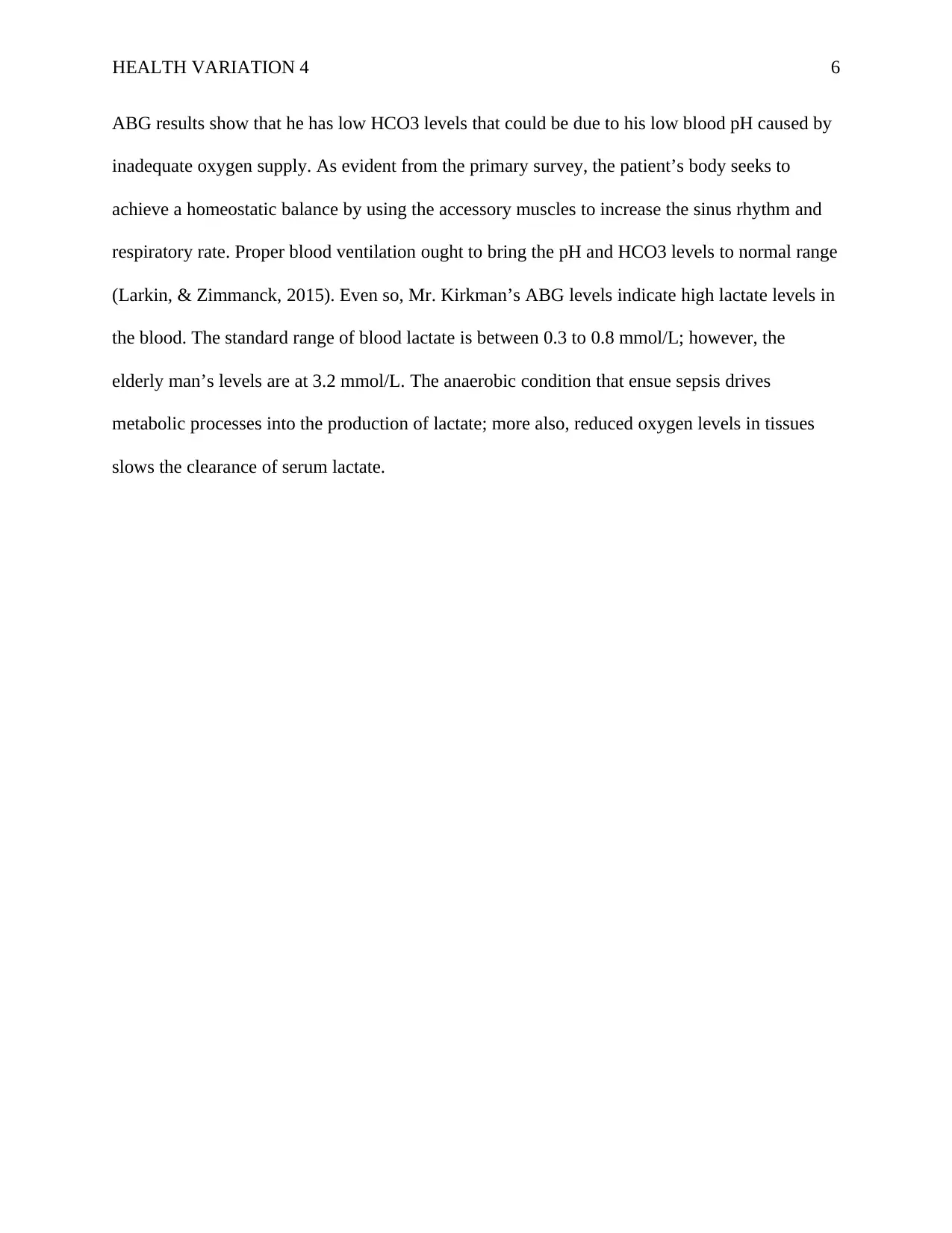
HEALTH VARIATION 4 6
ABG results show that he has low HCO3 levels that could be due to his low blood pH caused by
inadequate oxygen supply. As evident from the primary survey, the patient’s body seeks to
achieve a homeostatic balance by using the accessory muscles to increase the sinus rhythm and
respiratory rate. Proper blood ventilation ought to bring the pH and HCO3 levels to normal range
(Larkin, & Zimmanck, 2015). Even so, Mr. Kirkman’s ABG levels indicate high lactate levels in
the blood. The standard range of blood lactate is between 0.3 to 0.8 mmol/L; however, the
elderly man’s levels are at 3.2 mmol/L. The anaerobic condition that ensue sepsis drives
metabolic processes into the production of lactate; more also, reduced oxygen levels in tissues
slows the clearance of serum lactate.
ABG results show that he has low HCO3 levels that could be due to his low blood pH caused by
inadequate oxygen supply. As evident from the primary survey, the patient’s body seeks to
achieve a homeostatic balance by using the accessory muscles to increase the sinus rhythm and
respiratory rate. Proper blood ventilation ought to bring the pH and HCO3 levels to normal range
(Larkin, & Zimmanck, 2015). Even so, Mr. Kirkman’s ABG levels indicate high lactate levels in
the blood. The standard range of blood lactate is between 0.3 to 0.8 mmol/L; however, the
elderly man’s levels are at 3.2 mmol/L. The anaerobic condition that ensue sepsis drives
metabolic processes into the production of lactate; more also, reduced oxygen levels in tissues
slows the clearance of serum lactate.
⊘ This is a preview!⊘
Do you want full access?
Subscribe today to unlock all pages.

Trusted by 1+ million students worldwide
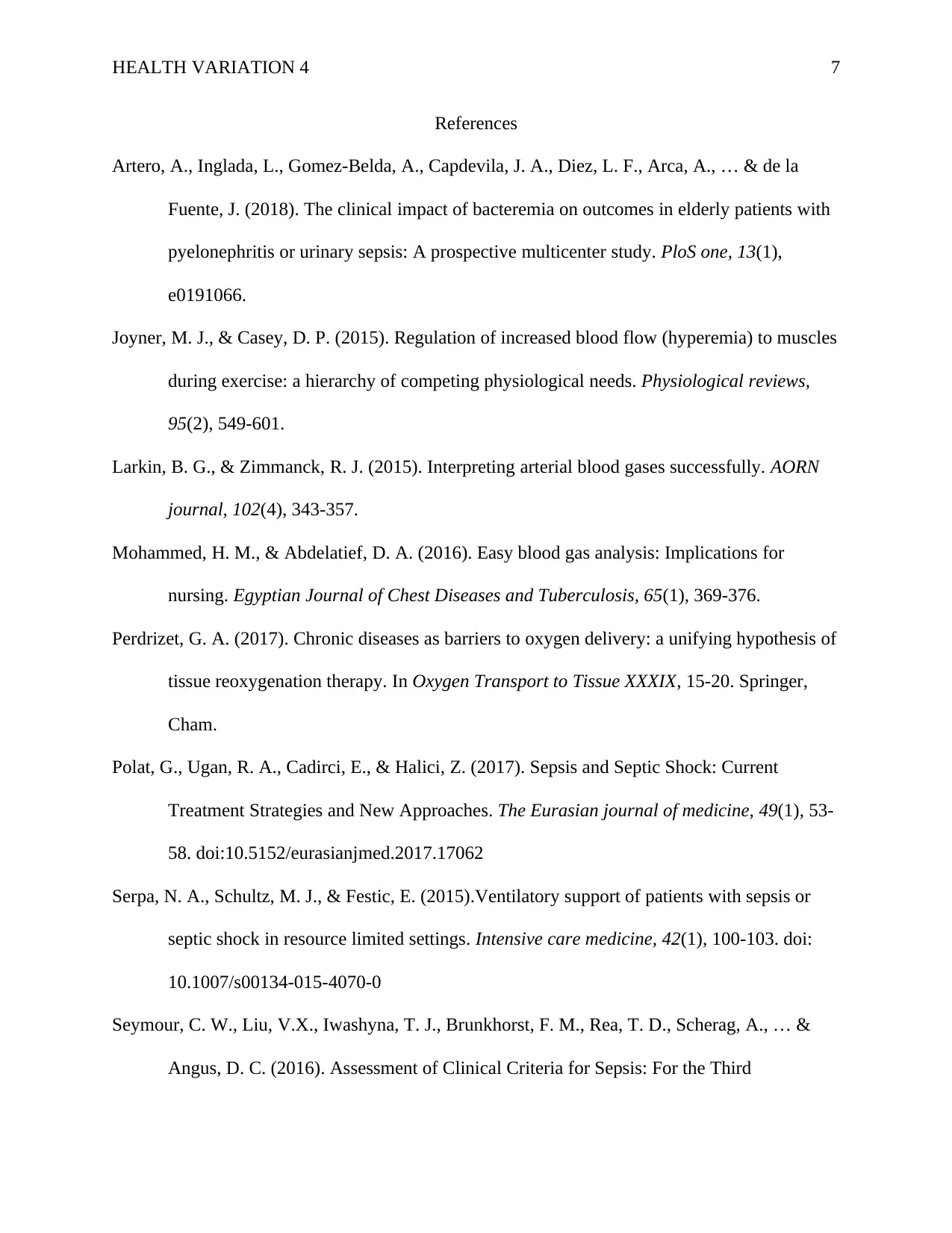
HEALTH VARIATION 4 7
References
Artero, A., Inglada, L., Gomez-Belda, A., Capdevila, J. A., Diez, L. F., Arca, A., … & de la
Fuente, J. (2018). The clinical impact of bacteremia on outcomes in elderly patients with
pyelonephritis or urinary sepsis: A prospective multicenter study. PloS one, 13(1),
e0191066.
Joyner, M. J., & Casey, D. P. (2015). Regulation of increased blood flow (hyperemia) to muscles
during exercise: a hierarchy of competing physiological needs. Physiological reviews,
95(2), 549-601.
Larkin, B. G., & Zimmanck, R. J. (2015). Interpreting arterial blood gases successfully. AORN
journal, 102(4), 343-357.
Mohammed, H. M., & Abdelatief, D. A. (2016). Easy blood gas analysis: Implications for
nursing. Egyptian Journal of Chest Diseases and Tuberculosis, 65(1), 369-376.
Perdrizet, G. A. (2017). Chronic diseases as barriers to oxygen delivery: a unifying hypothesis of
tissue reoxygenation therapy. In Oxygen Transport to Tissue XXXIX, 15-20. Springer,
Cham.
Polat, G., Ugan, R. A., Cadirci, E., & Halici, Z. (2017). Sepsis and Septic Shock: Current
Treatment Strategies and New Approaches. The Eurasian journal of medicine, 49(1), 53-
58. doi:10.5152/eurasianjmed.2017.17062
Serpa, N. A., Schultz, M. J., & Festic, E. (2015).Ventilatory support of patients with sepsis or
septic shock in resource limited settings. Intensive care medicine, 42(1), 100-103. doi:
10.1007/s00134-015-4070-0
Seymour, C. W., Liu, V.X., Iwashyna, T. J., Brunkhorst, F. M., Rea, T. D., Scherag, A., … &
Angus, D. C. (2016). Assessment of Clinical Criteria for Sepsis: For the Third
References
Artero, A., Inglada, L., Gomez-Belda, A., Capdevila, J. A., Diez, L. F., Arca, A., … & de la
Fuente, J. (2018). The clinical impact of bacteremia on outcomes in elderly patients with
pyelonephritis or urinary sepsis: A prospective multicenter study. PloS one, 13(1),
e0191066.
Joyner, M. J., & Casey, D. P. (2015). Regulation of increased blood flow (hyperemia) to muscles
during exercise: a hierarchy of competing physiological needs. Physiological reviews,
95(2), 549-601.
Larkin, B. G., & Zimmanck, R. J. (2015). Interpreting arterial blood gases successfully. AORN
journal, 102(4), 343-357.
Mohammed, H. M., & Abdelatief, D. A. (2016). Easy blood gas analysis: Implications for
nursing. Egyptian Journal of Chest Diseases and Tuberculosis, 65(1), 369-376.
Perdrizet, G. A. (2017). Chronic diseases as barriers to oxygen delivery: a unifying hypothesis of
tissue reoxygenation therapy. In Oxygen Transport to Tissue XXXIX, 15-20. Springer,
Cham.
Polat, G., Ugan, R. A., Cadirci, E., & Halici, Z. (2017). Sepsis and Septic Shock: Current
Treatment Strategies and New Approaches. The Eurasian journal of medicine, 49(1), 53-
58. doi:10.5152/eurasianjmed.2017.17062
Serpa, N. A., Schultz, M. J., & Festic, E. (2015).Ventilatory support of patients with sepsis or
septic shock in resource limited settings. Intensive care medicine, 42(1), 100-103. doi:
10.1007/s00134-015-4070-0
Seymour, C. W., Liu, V.X., Iwashyna, T. J., Brunkhorst, F. M., Rea, T. D., Scherag, A., … &
Angus, D. C. (2016). Assessment of Clinical Criteria for Sepsis: For the Third
Paraphrase This Document
Need a fresh take? Get an instant paraphrase of this document with our AI Paraphraser
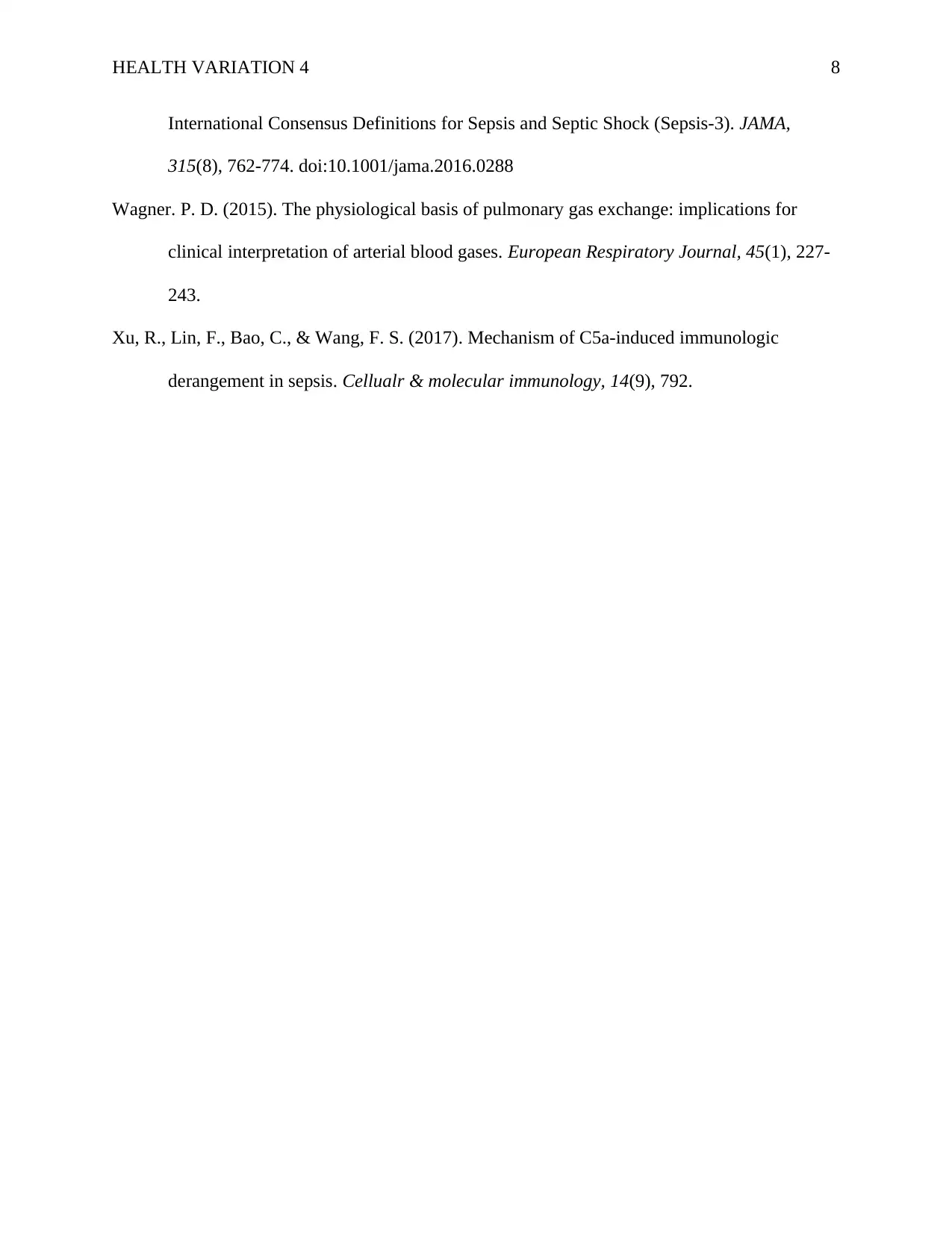
HEALTH VARIATION 4 8
International Consensus Definitions for Sepsis and Septic Shock (Sepsis-3). JAMA,
315(8), 762-774. doi:10.1001/jama.2016.0288
Wagner. P. D. (2015). The physiological basis of pulmonary gas exchange: implications for
clinical interpretation of arterial blood gases. European Respiratory Journal, 45(1), 227-
243.
Xu, R., Lin, F., Bao, C., & Wang, F. S. (2017). Mechanism of C5a-induced immunologic
derangement in sepsis. Cellualr & molecular immunology, 14(9), 792.
International Consensus Definitions for Sepsis and Septic Shock (Sepsis-3). JAMA,
315(8), 762-774. doi:10.1001/jama.2016.0288
Wagner. P. D. (2015). The physiological basis of pulmonary gas exchange: implications for
clinical interpretation of arterial blood gases. European Respiratory Journal, 45(1), 227-
243.
Xu, R., Lin, F., Bao, C., & Wang, F. S. (2017). Mechanism of C5a-induced immunologic
derangement in sepsis. Cellualr & molecular immunology, 14(9), 792.
1 out of 8
Related Documents
Your All-in-One AI-Powered Toolkit for Academic Success.
+13062052269
info@desklib.com
Available 24*7 on WhatsApp / Email
![[object Object]](/_next/static/media/star-bottom.7253800d.svg)
Unlock your academic potential
Copyright © 2020–2025 A2Z Services. All Rights Reserved. Developed and managed by ZUCOL.





